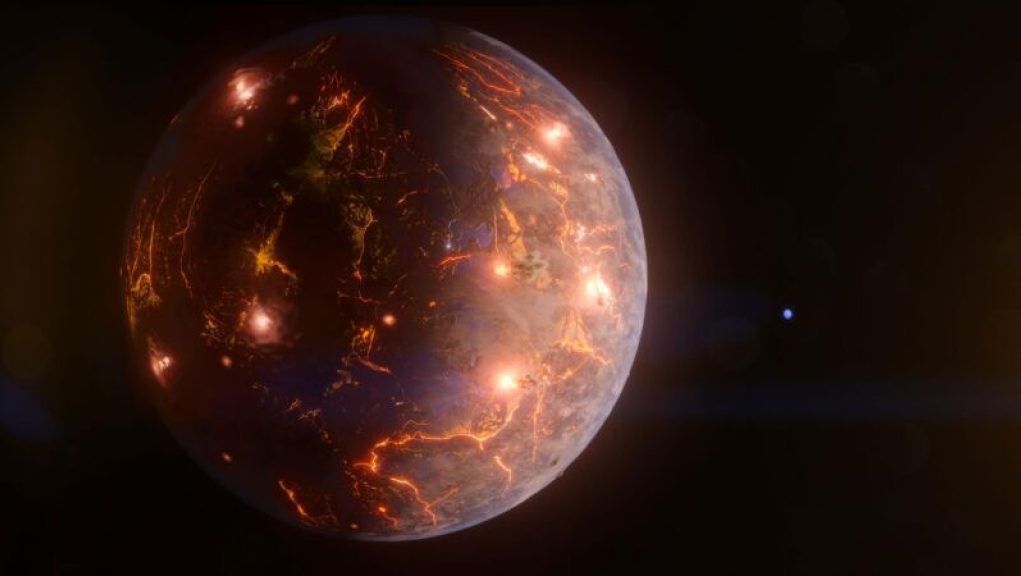Get ready to be amazed by the latest discovery in the world of exoplanets! We’ve always known very little about the exoplanets we’ve discovered, but when we start combining the few details we have, we can infer a lot. And that’s exactly what happened with the newly discovered exoplanet orbiting a small star about 90 light-years from Earth. This exoplanet has a radius and mass very similar to Earth’s, suggesting it also has a rocky composition. Plus, based on what we know of the star, it can potentially contain liquid water. And get this, it’s likely to have very active geology, potentially including volcanoes, thanks to the forces exerted by nearby planets.
The exosolar system at the star LP 791-18 was first discovered by the Transiting Exoplanet Survey Satellite (TESS). TESS had spotted two planets orbiting LP 791-18, which is one of the smallest—and thus dimmest—stars known to host planets. But their discovery led to some of the last observations done by the Spitzer Space Telescope before it was shut down, providing over five days of observations in total—just enough to capture two transits of LP 791-18c, the outermost planet, as it passed across the line of sight between its host star and Earth. But this data also captured two additional transits, suggesting that another planet might be present, orbiting between the two known planets.
That was enough to kick off a multi-year, multi-telescope effort that confirmed the existence of LP 791-18d, which takes a bit under three days to complete an orbit. But the effort went considerably beyond that by measuring variations in the timing of when planets transited in front of LP 791-18. These transit timing variations are caused by the relative positions of the three planets, which determine whether they produce gravitational tugs that either slow down or speed up their respective orbits.
By measuring enough of the transit timing variations, the researchers inferred how strong those gravitational tugs were and used that to get mass estimates for the outer two planets. For the outermost planet, LP 791-18c, the estimated mass is roughly seven times Earth’s. And get this, the newly discovered LP 791-18d has an Earth-like radius and a mass somewhat lower than Earth’s, but that’s still consistent with a largely rocky composition. This is truly an exciting discovery that sheds light on the mysteries of the universe.
Astronomers have made an incredible breakthrough discovery: a newly-found exoplanet may potentially have liquid-water oceans, as well as an abundant number of volcanoes. This has researchers caught in thrall of excitement and has implications significantly beyond the purely scientific.
The exoplanet, called Gliese 486b, orbits the star Glesse 486, which is a red dwarf star located 26 light years away from Earth in the constellation Virgo. The exoplanet is almost the same size as Venus and orbits very closely to its sun, completing one orbit every 1.5 Earth days. With its close proximity to its star, Gliese 486b is so hot that it’s believed to have a molten iron core.
Researchers at the University of Geneva model suggests that the surface of Glese 486b experiences temperatures between 470 to 800 °C (880 to 1,470 °F), which has scientists theorize its surface consists of a volcanic ocean of a molten material, probably a mix of lava and water. That not only places Gliese 486b as the warmest exoplanet ever discovered, but it also means that there is a statistically high amount of volanic activity on the planet, creating ideal conditions for life to form.
The presence of liquid water is another crucial factor for the potential development of life on Gliese 486b, and while scientists can’t confirm its presence yet, the high levels of volcanic activity lead them to believe that there is a possibility of existing liquid water based on heat transfer from the eruptions.
The implications of such a discovery are too immense to go unmentioned. The fact that Gliese 486b has all the right environmental conditions for life to thrive could mean that exoplanets like this one could be home to extraterrestrial life. Granted, much more needs to be studied and analyzed before any definitive conclusions can be reached, and this is only one possible starting block of many that may lead us to answering one of the oldest questions of mankind: Are we alone in the universe?
Regardless of the final outcome, this groundbreaking discovery has opened up a new world of possibilities in the search for exoplanets with potential habitability. We can only hope that, with enough research, these new possibilities can help us discover the answer sooner rather than later.




















